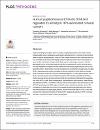Human papillomavirus E7 binds Oct4 and regulates its activity in HPV-associated cervical cancers.
Date
2020-04-16Author
Panayiotou, TheofanoMichael, Stella
Zaravinos, Apostolos
Demirag, Ece
Achilleos, Charis
Strati, Katerina
...show more authors ...show less authors
Metadata
Show full item recordAbstract
Octamer binding transcription factor-4 (Oct4), is highly expressed in stem cells and has indispensable roles in pluripotency and cellular reprogramming. In contrast to other factors used for cellular reprogramming, a role for Oct4 outside embryonic stem cells has been elusive and highly controversial. Emerging evidence implicates Oct4 in the carcinogenic process, but the mechanism through which Oct4 may be functioning in cancers is not fully appreciated. Here, we provide evidence that Oct4 is expressed in human cervical cancer and this expression correlates with the presence of the human papillomavirus (HPV) oncogenes E6 and E7. Surprisingly, the viral oncogenes can complement exogenously provided Oct4 in reprogramming assays, providing functional validation for their ability to activate Oct4 transcription in Mouse Embryonic Fibroblasts (MEFs). To interrogate potential roles of Oct4 in cervical cancers we knocked-down Oct4 in HPV(+) (HeLa & CaSki) and HPV(-) (C33A) cervical cancer cell lines and found that Oct4 knockdown attenuated clonogenesis, only in the HPV(+) cells. More unexpectedly, cell proliferation and migration, were differentially affected in HPV(+) and HPV(-) cell lines. We provide evidence that Oct4 interacts with HPV E7 specifically at the CR3 region of the E7 protein and that introduction of the HPV oncogenes in C33A cells and human immortalised keratinocytes generates Oct4-associated transcriptional and phenotypic patterns, which mimic those seen in HPV(+) cells. We propose that a physical interaction of Oct4 with E7 regulates its activity in HPV(+) cervical cancers in a manner not seen in other cancer types.
Collections
- Medicine Research [1913 items ]


